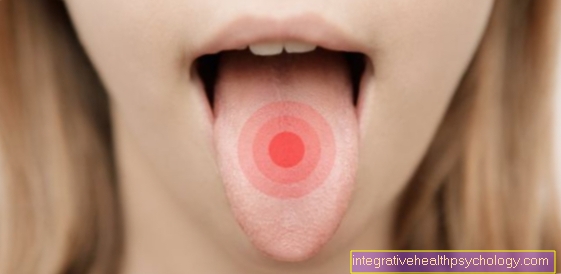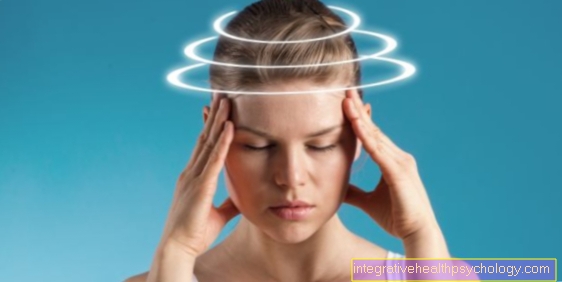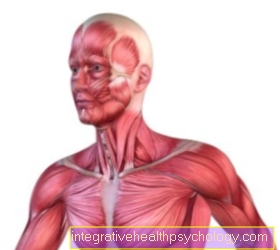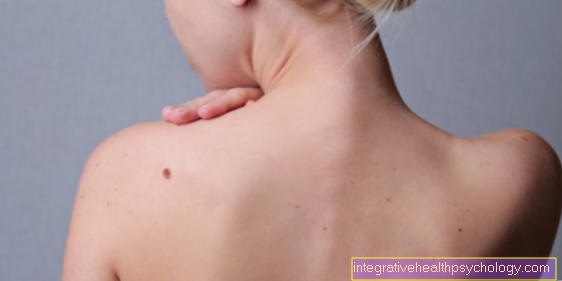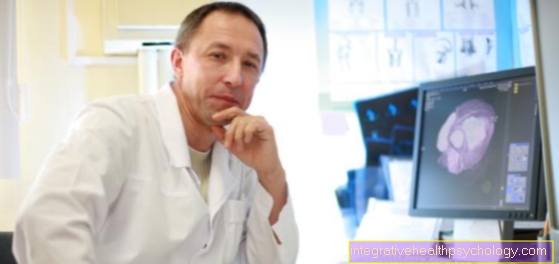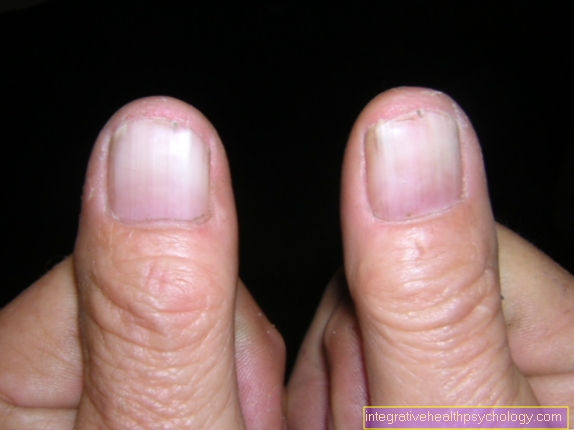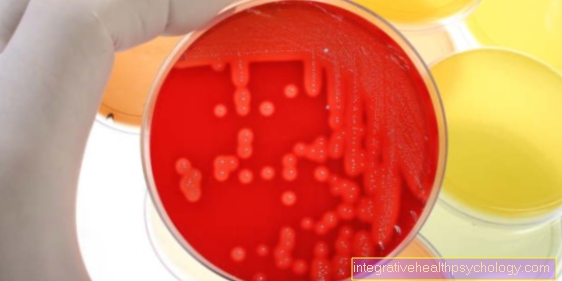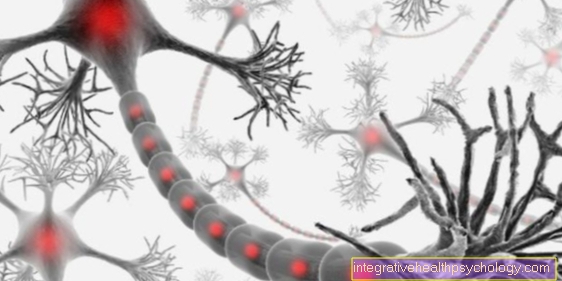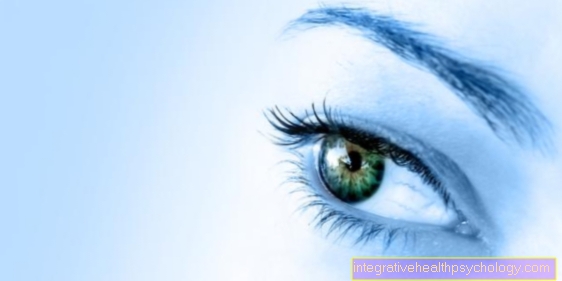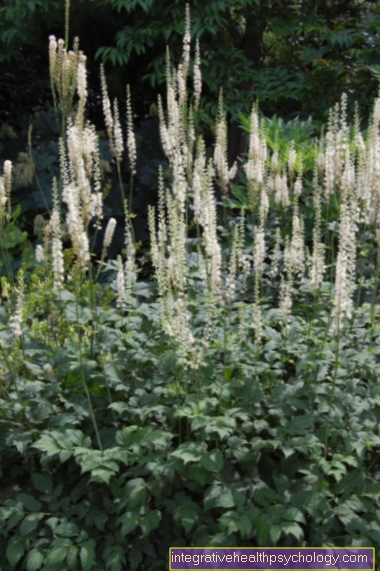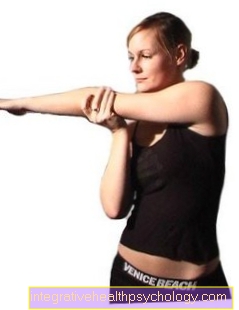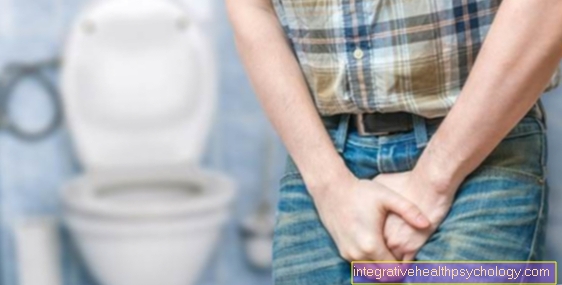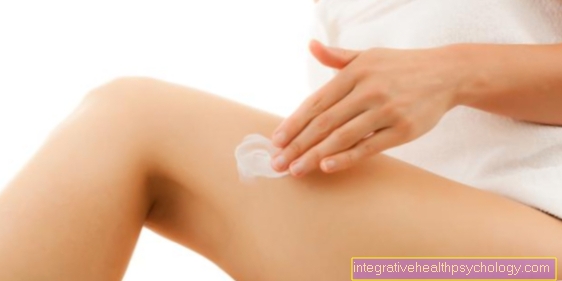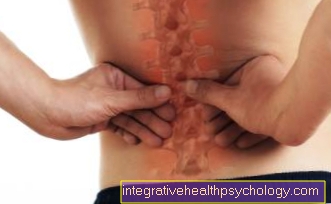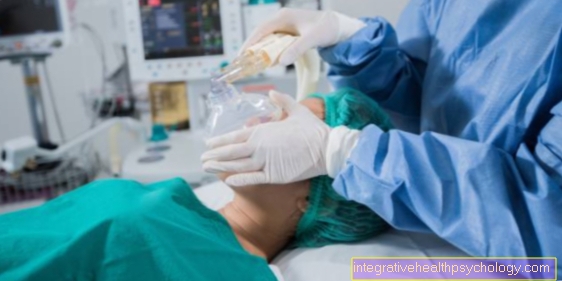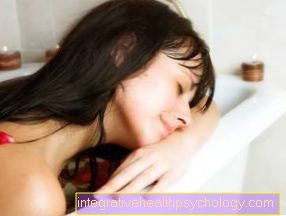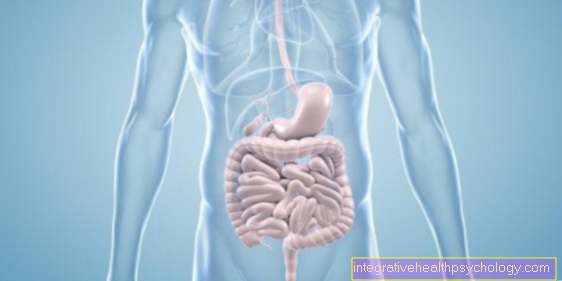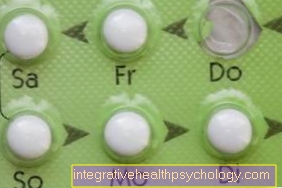Sternocleidomastoid muscle
introduction
The sternocleidomastoid muscle is colloquially referred to as "big head turner" or "head nod" according to its functions.
It can be felt as a superficial muscle on the front along the entire length of the neck and is made up of two heads.
The middle head (Caput mediale) arises from the upper section of the sternum (Manubrium sterni), the side head (Caput laterale) on the middle third of the bowl bone.
Both run diagonally from the front to the back, as well as from the bottom to the top over the neck and set together on the occiput, more precisely on a bone protrusion located there, the Mastoid process, at.
In its course, the two muscle heads unite to form a large muscle belly.

The muscle is created in pairs, i.e. the human has a sternocleidomastoid muscle on each side of the neck.
On the one hand, the muscle is innervated, i.e. supplied with nerve tissue that is important for its function Cranial nerves, the Accessory nerve, as well as direct branches from the Nerve plexus of the neck (Cervical plexus).
function
If only one of the two muscles contracts, this leads to one Tilt the head towards the shoulder, as well as to a Rotation to the opposite side. For example, if the right one pulls itself Sternocleidomastoid muscle together, the head turns to the left and leans slightly towards the right shoulder.
If both muscles contract, i.e. both the right and the left sternocleidomastoid muscle, both muscles pull at their point of attachment at the occiput of the head, which means that the face is lifted.
The muscles can also be called Auxiliary respiratory muscles function by slightly raising and lowering the collarbones and thereby improving and facilitating breathing, for example after great physical exertion.
Pain and tension
Like any other muscle, the sternocleidomastoid muscle can brace.
The result is pain in the head area, especially at Ears, eyes and face area. The tense muscle can also a headache to generate.
Since the muscle is made up of two parts, it can also be rough two pain zones be distinguished from each other. From the localization of the pain within a corresponding pain zone, it can then be deduced which part of the muscle must be tense.
As already described above, the muscle originates on the one hand Sternum (sternal part) and on the other on Collarbone (clavicular part).
If there is tension in the sternal part in particular, those affected often feel pain in the area of the Top and back of the head.
If the clavicular part is tense, the pain is more in the range of Forehead and ear localized.
It is not uncommon, however, that both muscle parts are tense to a certain extent and the pain zones are "blurred", meaning that they can no longer be precisely defined.
Strong tension is often expressed as sharp pains suddenly shooting into the throat. A tense sternocleidomastoid muscle can occur, especially in women Lump feeling in the throat cause. In technical terms, this problem is referred to as Globus hystericus.
Often the tension and the pain associated with it have one harmless causesuch as an unfavorable one taken overnight Head position, the longer sitting in Drafts, but also that unconscious tensing of the muscles during stress.
The muscle is also called when breathing is difficult Auxiliary respiratory muscles used to facilitate this. For this reason, the sternocleidomastoid muscle tenses very often in patients who are under a Lung disease, like for example COPD (chronic obstructive pulmonary disease) and for this reason are dependent on the aforementioned additional function of the muscle.
Massages can help to relieve tension and thereby subsequently alleviate the pain.
The entire length of the muscle can be easily reached with your own hands, which is why the massages can also be performed independently on the tension points.
The tension is as Tense muscles with local tenderness palpable.
A treatment with local heat, as Relaxation exercises can also help to relieve tension.
When massaging the muscle, care should be taken to ensure that the Main artery located directly in front of the muscle, which can be detected by the palpable pulse, is not massaged.
this could namely in the worst case, lead to fainting spells.
Stretching the muscle
Since the sternocleidomastoid muscle is one of the muscles that to Foreshortenings tend, a regular stretching of the muscle makes sense, especially for people who are pre-stressed.
To do this, first take a starting position in an upright position. Now press one of the two Palms towards the groundso that the shoulder of this half of the body also moves towards the floor. For example, start with the left palm. To do the following exercises with the other side as well, simply mirror them.
Breathe deeply and move her now Chin towards the right shoulder. The head tilts automatically with it.
The left sternocleidomastoid muscle stretched.
Arrived in this stretched position exhale slowly and continuously and persist about 15-20 seconds in this position.
Always change the starting position and sides between stretches so that each side and therefore each muscle is stretched three times.
The second exercise begins by placing your left hand over your head to your right ear grasp. Now turn yours Head in the opposite direction to the ear. So in our example to the left.
Again, change the starting position and sides three times.
For the last exercise, lean your head back. It is best to do this exercise sitting on a chair to be carried out with a backrest that is not too high.
If you have leaned your head back, turn it alternately slowly to the left and rightuntil you feel a maximum stretch on the corresponding muscle.
When twisting to the left, the right sternocleidomastoid muscle is stretched; when twisting to the right, the left muscle is stretched.
Repeat this exercise three times and stay in the respective position as well 15-20 seconds.
In addition, the muscle works with Shoulder circles With. For maximum effect, consider the circular motion backwards and downwards particularly emphasize.
Before performing the last exercise there should be a upright stance be taken. Now lift both arms so that they form a horizontal line at shoulder height, so that the arms are each in the 90 ° angle to the center of the body stand. The palm of one arm, for example the palm of the right, points towards the ceiling and that of the other arm, in our example now the palm of the left arm, points towards the floor.
During the course of the exercise, the Always turn your head towards the palm of your hand facing the ceiling. In our example, first to the right.
To change sides, the left palm is now turned towards the ceiling and the head is turned to the left. Before starting the head turn, you should go deep Breathe in slowly and consciously while turninguntil the head remains in the desired viewing direction.
Change the viewing directions and the positions of the palms 10-15 times.
Training the muscle
As with any muscle, it is recommended to also use the sternocleidomastoid muscle before training "Warm up".
For this purpose, the above can be used stretching be performed.
Exercises that specifically train this muscle are unfortunately rare compared to training units for other muscles. The good news, however, is that many exercises, especially those aimed at the Strengthening of the neck and throat muscles, can be used and thus trained in this way.
Even when performing Sit ups the muscles are also tensed.
A well trained neck and throat muscles is especially common in certain sports, such as Boxing or rugby of great importance as it provides stability and a degree of protection to the cervical spine.
The following exercises focus specifically on training the great head turner.
At the beginning of the first exercise, a upright stance taken and the heel of the hand of one palm, for example the left, placed on the ear on the same side of the body.
The The upper arm is at a 90 ° angle to the bodyso that the elbow is a continuation of the shoulder line.
The next step is to press your hand against your head while trying to resist this pressure with your head by turning it in the opposite direction.
For example, if you press with your left hand on your left ear, turn your head to the left, as your hand would then press it to the right.
It is recommended to repeat the exercise three times on each side and each time 15-20 seconds To build up pressure or to offer resistance against it.
The next exercise is mainly training both nods, however, also strengthens the Neck muscles. As a starting position, lie down with your back on the floor. Now place your palms on your forehead and lift your head up so that your chin touches your chest. At the same time, you apply opposite pressure to your forehead with your palms.
Try this position 10-15 seconds and then bring your head back towards the floor without putting it down. The exercise should be repeated 3-4 times.
Wry neck / torticollis
Under a Torticollis one understands a tilted position of the head. This deformity can be congenital or acquired.
A congenital muscular torticollis, which is usually visible in infancy, is in almost all cases Malformation of the sternocleidomastoid muscle fundamentally.
The causes of this form of torticollis are not yet fully understood. It will, however Undersupply of the muscle with blood during pregnancy, as well Muscle injuries and bleeding during childbirth discussed as causes.
Furthermore, a unfavorable position of the child in the womb contribute to the development of a torticollis.
It has been observed that the torticollis is often combined with other malformations, such as Club feet or hip dysplasia occurs.
The sternocleidomastoid muscle is shortened in this congenital form of the disease.
Furthermore, there is a replacement of muscle tissue by connective tissue, which is less elastic and cannot replace the functions of the muscle tissue.
The risk of congenital muscular malformation is that the spine tries to adjust its position to the constant head misalignment.
Eventually, over time, those affected very often develop what is called one Scoliosis, including a Curvature of the spine understands.
Due to the constant pull that is on the deformed muscle, some of the affected people tear and, as a result, become Hemorrhage in the remaining muscle part. This creates a bruise, technically known as a hematoma, in this muscle.
The head nodding hematoma is usually palpable in children as a small swelling below the ear.
If a torticollis is suspected, the baby should be given a physiotherapy treatment should be tackled, because within the first year of life, some sufferers still have the option of successfully treating them conservatively.
In addition, with the help of physiotherapy exercises, the Head mobility can be obtained.
From the first year of life and in those patients in whom physiotherapy has not shown sufficient effect, the torticollis becomes surgically treated.
The shortened muscle is cut through at both ends by means of a small incision and the head is then fixed with a splint for about 8 weeks.
During this time, the cut surfaces grow together in an anatomically correct position.
In addition to the already explained innate muscular cause there are numerous other causes of torticollis, such as bony, spastic, rheumatic or infectious torticollis.
All other causes have in common that the neck and throat muscles, including the sternocleidomastoid muscles (plural of sternocleidomastoid muscles) are indirectly affected.
Due to the constant incorrect posture of the head, the muscles are in many of those affected painfully hardened and tense.
If the misalignment is not corrected, over time there is a risk that the muscles on the inclined side of the head will try to adapt to the changed position and shorten accordingly.
This is one of the reasons why torticollis, especially if it has lasted for a long time, among other things physiotherapy should be treated.
Bezold abscess
The Bezold abscess is a possible consequence of a acute otitis media.
These very rare complication is named after its discoverer Friedrich Bezold.
An abscess is generally understood to be a purulent encapsulation caused by certain bacteria, the so-called Staphylococci, is triggered.
These pathogens can also be the cause of acute otitis media. If such an inflammation has occurred, there is a risk that the bacteria will spread even further. Occasionally they also get into those near the middle ear Mastoid process.
The mastoid process is a Bone protrusion on the occiputto which the sternocleidomastoid muscle attaches. He owns one Cavity, which is lined with mucous membrane is. This can be colonized by the spreading bacteria and also inflame purulent. One then speaks of one Mastoiditis.
Since the head-turning muscle has its starting point at this protrusion, there is a risk that the pus will not only remain in the mastoid process, but will break through it and spread further into the sternocleidomastoid muscle.
This so-called abscess formation in the muscle is called a Bezold abscess. This makes up as one painful swelling in the neck noticeable. The skin above the inflammation may also be reddened and overheated.
Mastoiditis and the Bezold abscess associated with an invasion of pus in the sternocleidomastoid muscle must be treated immediately with the help of Antibiotics and often one too small operation treated to prevent the bacteria from spreading, especially towards Brain and meninges, to avoid.
In many cases, as already mentioned, a small operation is necessary to remove the pus opened, the Drained pus and the adjacent structures, such as the bones, are relieved and subsequently also cleaned.

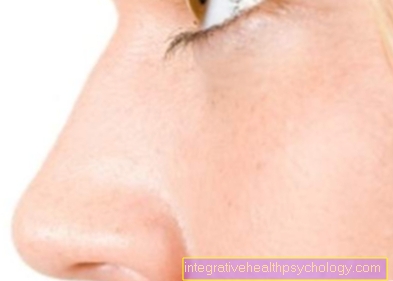
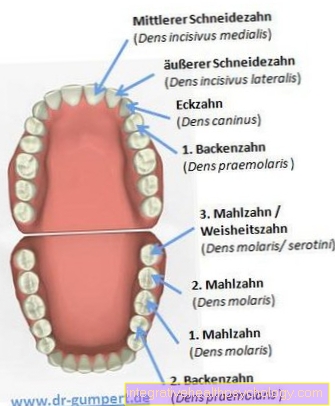
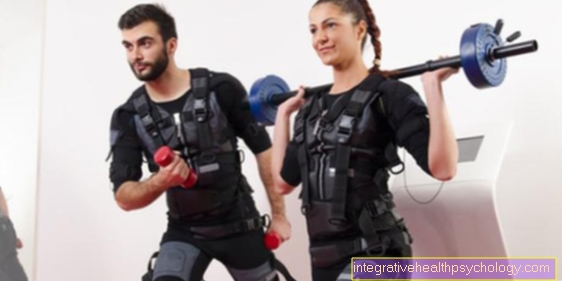
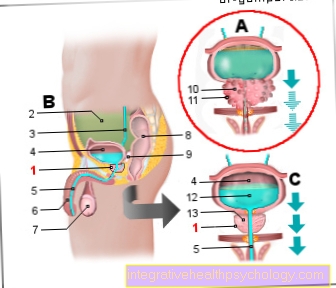
.jpg)
